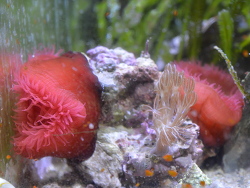Info
Actinia mediterranea Schmidt, 1971
Actinia mediterranea is a common sea anemone found on rocky shores throughout the Mediterranean, Portuguese shores, and the coast of northwest Africa. Because of its strong resemblance to Actinia equina, it is often confused with it.
Actinia mediterranea is a solitary anemone that attaches firmly to rocks with its foot. Underwater, this anemone displays a large number of short and retractable tentacles arranged in six concentric rows. The soft column is smooth and bright red with a fine blue border at the base of the foot. This characteristic blue border is a prominent detail to distinguish it from Actinia equina. Another characteristic to distinguish it is the size. Actinia mediterranea grows slightly larger (5 to 7 cm) than its close relative (3 to 5 cm).
This anemone is perfectly adapted to harsh living conditions and tolerates tides, temperature and salinity fluctuations, and desiccation. At low tide, the tentacles retract and the anemone resembles a compact red spot and looks like a small tomato.
Actinia mediterranea lives benthically and is an active carnivore. It is nocturnal and catches its prey with cnidarian tentacles. Its diet consists of zooplankton, small fish, tiny crustaceans, and organic detritus floating in the water.
Direct human contact by touching with bare hands should be avoided. Allergic reactions or burning may occur if a sensitive part of the body, such as eyelids or lips, comes into contact with the remaining nettle cells on the hands.
Synonyms:
Actinia equina mediterranea Schmidt, 1971
Actinia schmidti Monteiro, Sole-Cava & Thorpe, 1997
Actinia mediterranea is a common sea anemone found on rocky shores throughout the Mediterranean, Portuguese shores, and the coast of northwest Africa. Because of its strong resemblance to Actinia equina, it is often confused with it.
Actinia mediterranea is a solitary anemone that attaches firmly to rocks with its foot. Underwater, this anemone displays a large number of short and retractable tentacles arranged in six concentric rows. The soft column is smooth and bright red with a fine blue border at the base of the foot. This characteristic blue border is a prominent detail to distinguish it from Actinia equina. Another characteristic to distinguish it is the size. Actinia mediterranea grows slightly larger (5 to 7 cm) than its close relative (3 to 5 cm).
This anemone is perfectly adapted to harsh living conditions and tolerates tides, temperature and salinity fluctuations, and desiccation. At low tide, the tentacles retract and the anemone resembles a compact red spot and looks like a small tomato.
Actinia mediterranea lives benthically and is an active carnivore. It is nocturnal and catches its prey with cnidarian tentacles. Its diet consists of zooplankton, small fish, tiny crustaceans, and organic detritus floating in the water.
Direct human contact by touching with bare hands should be avoided. Allergic reactions or burning may occur if a sensitive part of the body, such as eyelids or lips, comes into contact with the remaining nettle cells on the hands.
Synonyms:
Actinia equina mediterranea Schmidt, 1971
Actinia schmidti Monteiro, Sole-Cava & Thorpe, 1997







 Anne Frijsinger & Mat Vestjens, Holland
Anne Frijsinger & Mat Vestjens, Holland
























